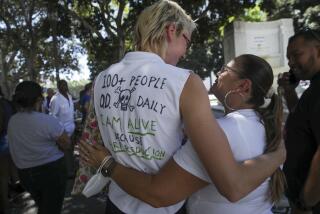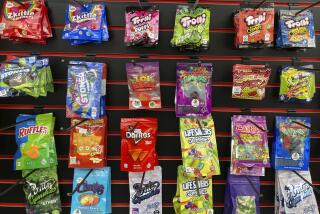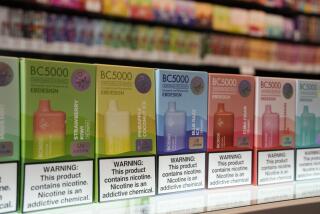Teen Drug Use Has Doubled in 4 Years, U.S. Says
- Share via
WASHINGTON — Drug use by teenagers has more than doubled in the last four years, with nearly 11% now claiming to use drugs each month, according to a new government survey that touched off a heated exchange Tuesday between the presidential campaigns.
An annual survey by the Department of Health and Human Services found that, when asked, more than 2.4 million youths between the ages of 12 and 17 admitted using an illicit drug at least once during the previous month. The comparable figure in 1992 was about 1.1 million.
“It’s an explosion in drug use,” said Barry R. McCaffrey, director of the White House Office of National Drug Control Policy.
The drug of choice by far is marijuana, which was cited by 8.2% of the teenagers. By comparison, 0.8% said they had used cocaine. Most drug abuse experts said that the statistics released Tuesday were expected. Studies by the government and by universities around the country have documented an upward trend in teenage drug abuse since the early 1990s.
Even so, Republicans reacted swiftly to the new figures, charging that the Clinton administration had not attacked the nation’s drug problems aggressively.
Republican presidential nominee Bob Dole declared the trend a “national tragedy” that has occurred on Clinton’s watch. “Starting next January, I’m going to make the drug war priority No. 1 once again,” Dole said during a campaign speech to members of the Veterans of Foreign Wars in Louisville, Ky.
“The statistics confirm an upward spiral of drug abuse across the nation since President Clinton took office,” Sen. Orrin G. Hatch (R-Utah), chairman of the Senate Judiciary Committee, said in a letter to McCaffrey.
And Republican National Committee Chairman Haley Barbour said that the administration has sent signals to teenagers that drug abuse is “no big deal.”
“We shouldn’t be surprised that Clinton is losing the war on drugs,” Barbour said. “From the beginning, he has treated illegal drug use with a wink and a nod in his policies, appointments and the attitude of his administration.”
Barbour was referring to a cut in funding for the drug policy office that Clinton authorized early in his administration, and later restored, as well as to recent reports that the White House has hired staff members who had used drugs in the past.
The administration has said that 21 employees were allowed to continue working despite evidence that they had used drugs within a year of their date of hire. Of those, only nine remained as of mid-July. The White House complex has about 1,700 workers.
Administration officials offered a different view Tuesday and they chided House Republicans for their proposal to cut $185 million from the president’s 1997 budget for the Substance Abuse and Mental Health Services Administration.
White House Press Secretary Mike McCurry said: “The one thing we can’t do is turn drug use among young people into a political football because that is the wrong message for kids. They’ll just think it’s an issue for the politicians and not something that they have to accept responsibility for.”
Health and Human Services Secretary Donna Shalala defended the administration’s record and said that the trend in drug use “is not something that just happened recently.”
“What we are seeing is something very serious--a multiyear trend that began before this administration came to Washington,” she said.
Federal surveys dating back to the Carter administration show a steady decline in drug use among teenagers through 1992, President Bush’s last year in office. In 1979, 16.3% claimed to have used an illicit drug in the previous month. The percentage fell to 5.3% in 1992 and rose to 10.9% in 1995.
But Shalala and McCaffrey released detailed studies showing that attitudes about marijuana use began to change in 1990 and 1991. One study found that from 1990 to 1993, the percentage of high school seniors who disapproved of marijuana use fell slightly, as did the percentage of those who saw the drug as a health risk.
Another study found that marijuana use among eighth-graders began to increase in 1991.
More to Read
Sign up for Essential California
The most important California stories and recommendations in your inbox every morning.
You may occasionally receive promotional content from the Los Angeles Times.










